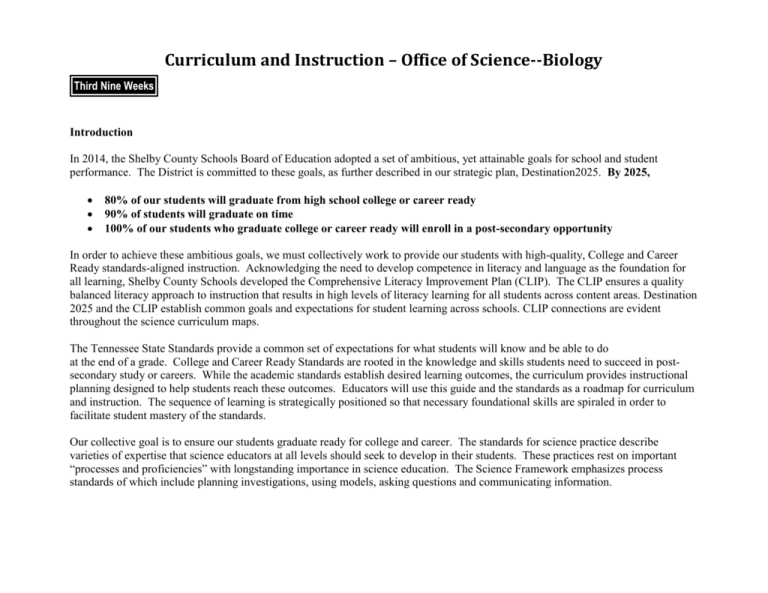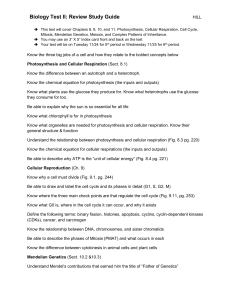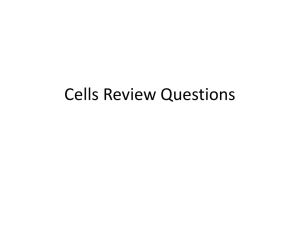Curriculum and Instruction * Office of Science-
advertisement

Curriculum and Instruction – Office of Science--Biology Third Nine Weeks Introduction In 2014, the Shelby County Schools Board of Education adopted a set of ambitious, yet attainable goals for school and student performance. The District is committed to these goals, as further described in our strategic plan, Destination2025. By 2025, 80% of our students will graduate from high school college or career ready 90% of students will graduate on time 100% of our students who graduate college or career ready will enroll in a post-secondary opportunity In order to achieve these ambitious goals, we must collectively work to provide our students with high-quality, College and Career Ready standards-aligned instruction. Acknowledging the need to develop competence in literacy and language as the foundation for all learning, Shelby County Schools developed the Comprehensive Literacy Improvement Plan (CLIP). The CLIP ensures a quality balanced literacy approach to instruction that results in high levels of literacy learning for all students across content areas. Destination 2025 and the CLIP establish common goals and expectations for student learning across schools. CLIP connections are evident throughout the science curriculum maps. The Tennessee State Standards provide a common set of expectations for what students will know and be able to do at the end of a grade. College and Career Ready Standards are rooted in the knowledge and skills students need to succeed in postsecondary study or careers. While the academic standards establish desired learning outcomes, the curriculum provides instructional planning designed to help students reach these outcomes. Educators will use this guide and the standards as a roadmap for curriculum and instruction. The sequence of learning is strategically positioned so that necessary foundational skills are spiraled in order to facilitate student mastery of the standards. Our collective goal is to ensure our students graduate ready for college and career. The standards for science practice describe varieties of expertise that science educators at all levels should seek to develop in their students. These practices rest on important “processes and proficiencies” with longstanding importance in science education. The Science Framework emphasizes process standards of which include planning investigations, using models, asking questions and communicating information. Curriculum and Instruction – Office of Science--Biology Third Nine Weeks Construct explanations and design solution Obtain, evaluate, and communicate information Engage in argument Ask questions and define problems Patterns Develop and use models Practices in Science Use math, technology, and computational thinking Plan and carry out investigations Cause and Effect Stability and change Cross Cutting Concepts Analyze and interpret data Energy and matter Systems and system models Crosscutting concepts have value because they provide students with connections and intellectual tools that are related across the differing areas of disciplinary content and can enrich their application of practices and their understanding of core ideas. Throughout the year, students should continue to develop proficiency with the eight science practices. Crosscutting concepts can help students better understand core ideas in science and engineering. When students encounter new phenomena, whether in a science lab, field trip, or on their own, they need mental tools to help engage in and come to understand the phenomena from a scientific point of view. Familiarity with crosscutting concepts can provide that perspective. A next step might be to simplify the phenomenon by thinking of it as a system and modeling its components and how they interact. In some cases it would be useful to study how energy and matter flow through the system, or to study how structure affects function (or malfunction). These preliminary studies may suggest explanations for the phenomena, which could be checked by predicting patterns that might emerge if the explanation is correct, and matching those predictions with those observed in the real world. Curriculum and Instruction – Office of Science--Biology Third Nine Weeks Science Curriculum Maps This curriculum map is designed to help teachers make effective decisions about what science content to teach so that, our students will reach Destination 2025. To reach our collective student achievement goals, we know that teachers must change their instructional practice in alignment with the three College and Career Ready shifts in instruction for science. To ensure that all student will be taught science content and processes in a comprehensive, consistent, and coherent manner, Science Curriculum Maps are provided. Foundation texts for the maps include Shelby County Schools Framework for Standards Based Curriculum, Science Curriculum Frameworks-K-12 (State of Tennessee Board of Education, and National Science Education Standards). Teachers function most effectively and students learn best within an “aligned” curriculum delivery system. An aligned system begins with a concerted effort to implement the state curriculum frameworks. Many districts have developed curriculum guides built around these frameworks to ensure that what is taught in particular grades and courses is closely linked with student Learning Expectations found in the state standards. Classroom teachers use these locally-generated curriculum guides to plan and implement their individual grade or course Pacing Guides. Expectations for student performance are clear and carefully tied to daily instructional events and classroom assessment practices. In theory, a fully aligned system closes the loop between state standards and student learning. Additionally, a coherent instructional/assessment system offers the potential for heightening student learning as reflected by their performance on state-mandated standardized tests. Our collective goal is to ensure our students graduate ready for college and career. Most of the elements found in the state Curriculum Frameworks were incorporated into the curriculum mapping material prepared by Shelby County Schools. Additional features were included to add clarity and to offer avenues that could assist teacher in developing grade level lessons. A district-wide, K-12, standards-based curriculum is implemented in science. This curriculum is articulated in the form of individual SCS curriculum maps for each grade and subject. These SCS curriculum maps enable the district to implement a single curriculum that emphasizes specific standards. Since Shelby County has a high rate of mobility among the student population, the SCS curriculum maps ensure that all students receive the same program of high-level instructional content and academic expectations, regardless of which school they attend. The utilization of a district-wide standards-based curricular program ensures that students in SCS are engaged in hands-on inquiry based activities as teachers implement the curriculum map. High School Science: Curriculum Map for Biology Third Nine Weeks State Standards Embedded Standards Outcomes Resources Connections Unit 3.1 Cellular Energy -3 weeks CLE 3210.3.2 Distinguish between aerobic and anaerobic respiration. CLE 3210.3.3 Investigate the relationship between the process of photosynthesis and cellular respiration. CLE 32010.Math.2 Utilize appropriated mathematical equations and processes to understand biological concepts. CLE 3210.Inq.2 Design and conduct scientific investigations to explore new phenomena verify previous results test how well a theory predicts, and compare opposing theories. CLE 3210.Inq.5 Compare experimental evidence and conclusions with those drawn by others about the same testable question. . Distinguish between aerobic and anaerobic respiration. Construct a concept map to differentiate between aerobic and anaerobic respiration. Compare and contrast photosynthesis and cellular respiration in terms of energy transformation. Conduct experiments to determine the factors that affect the rate of photosynthesis. Design and conduct an experiment to investigate whether plants release carbon dioxide. Conduct experiments to investigate photosynthesis and cellular respiration. Investigate the process of fermentation. Glencoe Chapter 8 pages 217-241 8.1 – how Organisms Obtain Energy 8.2 – Photosynthesis 8.3 – Cellular Respiration www.biologygmh.com Scientific Argumentation in Biology—Activity 18-Plants and Energy (Cellular Respiration and Photosynthesis) p. 218 Scientific Argumentation in Biology—Activity 12-Plant Biomass (Photosynthesis) p. 149 Mini-Lab “Relate Photosynthesis to Cellular Respiration,” p 220. Mini-Lab Observe Chloroplasts p. 223 Teacher Demonstration Photosynthesis p. 224 Biolab “ “Rate of Photosynthesis,” p. 235 www.biologygmh.com TE p. 216 Academic Vocabulary Energy, thermodynamics, metabolism, photosynthesis, cellular respiration, adenosine triphosphate, thylakoid, granum, stroma, pigment, NADP+, Calvin cycle, rubisco, anaerobic process, aerobic respiration, glycolysis, Krebs cycle, fermentation Follow precisely a complex multistep procedure when carrying out experiments, taking measurements, or performing technical tasks, attending to special cases or exceptions defined in the text. Students will make foldable to understand how all organisms get energy form food through cellular respiration p. 217. Creative writing – Students will write a short poem describing the flow of energy from autotrophs to heterotrophs. P. 219 Using a model, illustrate that cellular respiration is a chemical process whereby the bonds of food molecules and oxygen molecules are broken 4 2015-2016 High School Science: Curriculum Map for Biology Third Nine Weeks State Standards Embedded Standards Outcomes Resources Glencoe Resources TE p. 216 Respiration and Photosynthesis Review Photosynthesis Millionaire Prentice Hall Chapter 9 pages 221-225 Activities/Labs TE: Build Science Skills, p224 SE: *Inquiry Act, p220 *Problem Solving, p224 *Real-World Lab, pp234235 Lab Worksheets: Ch 9 BTM: Lab 1 Connections and the bonds in new compounds are formed resulting in a net transfer of energy NGSS Practices 3. Planning and carrying out investigations 4. Analyzing and interpreting data. 5. Using a model, illustrate how photosynthesis transforms light energy into stored chemical energy. Math.Practice.MP2 Reason abstractly and quantitatively. Vernier Biology #s 11 A- 11 B Vernier Biology #s 31A – 31 B Unit 3.2 – Sexual and Asexual Cellular Reproduction -2 Weeks CLE 3210.1.4 Describe the process of cell growth and reproduction. CLE3210.Inq.4 Apply qualitative and quantitative measures to analyze data and draw conclusions that are free of bias. . Determine the relationship between cell growth and cell reproduction. Demonstrate the movement of chromosomes during mitosis in plant and animal cells. Demonstrate the movement of chromosomes during mitosis in plant and animal cells. Glencoe Chapter 9 9.1 Cellular Growth 9.2 Mitosis and Cytokinesis 9.3 Cell Cycle Regulation Launch Lab – From where do healthy cells come? P. 243 Cells Alive: Mitosis Mitosis Tutorial Academic Vocabulary Cell cycle, interphase, mitosis, cytokinesis, chromosome, chromatin, prophase, sister chromatid, centromere, spindle apparatus, metaphase, anaphase, telophase, cyclin, cyclindependent kinase, cancer, carcinogen, apoptosis, stem cell 5 2015-2016 High School Science: Curriculum Map for Biology Third Nine Weeks State Standards Embedded Standards Outcomes Resources Connections Mitosis Quiz Mini Lab – Investigate Cell Size p. 245 Data Analysis Lab. P. 251 Critical Thinking –Observe and Infer p. 254 Scientific Argumentation in Biology--Activity 11Spontaneous Generation (Cell Theory) p. 137 Comparison of Mitosis and Meiosis Cell Growth Mitosis internet activity Prentice Hall Chapter 10 pages 241-252 Activities/Labs (Sect 10-1) TE: Build Science Skills SE: *Inq Act, p240 *QuickLab, p242 (Sect 10-2) TE: *Demo, p244 *Build Sci Skills, pp245, 246, 247 SE: *Analyzing Data, p249 *Exploration, pp254-255 LMA: Ch 10 LMB: Ch 10 BTM: Lab 3 Mitosis and Cytokinesis – Students will make a foldable to help understand how cells reproduce by a process called mitosis, resulting in two genetically identical cells. Big Idea Have students make a concept map using the terms cell cycle, mitosis, interphase, cytokinesis, anaphase, metaphase, prophase, and telophase. Narrative Writing Have students write a paragraph containing the words chromosomes, sister chromatids, and centromere. Students’ paragraph should demonstrate the correct usage of each of these terms. Read Biology and Society p. 258 – Students will create a pamphlet depicting the benefits of adult stem cell research. NGSS Practices 1. Using a model, illustrate the role of cellular division (mitosis) and differentiation in producing and maintaining complex organisms. 6 2015-2016 High School Science: Curriculum Map for Biology Third Nine Weeks State Standards Embedded Standards CLE 3210.4.5 Recognize how meiosis and sexual reproduction contribute to genetic variation in a population. CLE3210.Inq.5 Compare experimental evidence and conclusions with those drawn by other about the same testable question. Outcomes Resources Describe how meiosis is involved in the production of egg and sperm cells. Glencoe Chapter 10 pages 268-291 10.1 Meiosis Explain how meiosis results in the production of haploid cells and how this influences genetic variation. Launch Lab -- What Would Happen Without Meiosis? TE p. 269 Academic Vocabulary Gene, homologous chromosome, gamete, haploid, fertilization, diploid, meiosis, crossing over, Activity – Variation p. 275 Illustrating Meiosis – Students will make a foldable to help sequence, illustrate, and explain the phase of meiosis. Prentice Hall Chapter 11 pages 263-278 and Chapter 14 pages 349-354 Reading Strategy – Have students do the five steps SQ3R - page 271 SECTION 11-1 Activities/Labs TE: *Build Science Skills, p263, 266 *Demo, p265 SE: *Inquiry Act, p262 SECTION 11-4 Activities/Labs TE: *Demo, p277 *Build Science Skills, p278 SE: Exploration, p281 Writing Support- Informal Writing – Have students write a letter from a cell’s point of view about the changes that happen to its chromosomes during meiosis, p. 272, Data Analysis Lab. P. 274 Associate gene mutation with changes in a DNA molecule. Connections Creative Writing – Have students write a poem about the stages of meiosis I and II. Their poem can be humorous or serious but should be scientifically accurate. Have a live poetry reading. p. 275 NGSS 7. Make and defend a claim based on evidence that inheritable genetic variations may result from: (1) new genetic combinations through 7 2015-2016 High School Science: Curriculum Map for Biology Third Nine Weeks State Standards Embedded Standards Outcomes Resources Connections meiosis, (2) viable errors occurring during replication, and/or (3) mutations caused by environmental factors. Unit 3.3 Mendelian Genetics - 4 Weeks CLE 3210.4.3 Predict the outcome of monohybrid and dihybrid crosses. CLE 32010.Math.2 Utilize appropriated mathematical equations and processes to understand biological concepts. Determine the probability of a particular trait in an offspring based on the genotype of the parents and the particular mode of inheritance. Glencoe Chapter 10 pages 277-291 Apply data to complete and interpret a genetic pedigree. Mini-Lab Predict Probability in Genetics p. 281 and Map Chromosomes p. 284 10.2 Mendelian Genetics 10.3 Gene Linkage and Polyploidy Scientific Argumentation in Biology—Activity 16Environmental Influence of Genotypes and Phenotypes (Genetics) p. 191 Text Sect 11-2: 267-269 Activities/Labs TE: *Make Connections, p267 *Build Science Skills, p269 SE: Quick Lab, p268 Academic Vocabulary genetics, allele, dominant, recessive, homozygous, heterozygous, genotype, phenotype, law of segregation, hybrid, law of independent assortment, genetic recombination, polyploidy Translate quantitative or technical information expressed in words in a text into visual form (e.g., a table or chart) and translate information expressed visually or orally. Writing Strategy – Creative Writing – Have students work in pairs to create a cartoon about the inheritance of more than one trait in pea plants. p. 280 NGSS Practices 5. Using mathematics and computational thinking. 2. Developing and using models. 8 2015-2016 High School Science: Curriculum Map for Biology Third Nine Weeks State Standards Embedded Standards CLE 3210.4.4 Compare different modes of inheritance: sex linkage, co-dominance, incomplete dominance, multiple alleles, and polygenetic traits. CLE 3210.Inq.4 Apply qualitative and quantitative measures to analyze data and draw conclusions that are free of bias. Outcomes Describe how the process of meiosis controls the number of chromosomes in a gamete. Explain the processes of segregation of alleles and independent assortment of alleles in terms of the number of chromosomes present in given cells during meiosis. Compare different modes of inheritance: sex linkage, codominance, incomplete dominance, multiple alleles, and polygenic traits. Resources Glencoe Chapter 11 11.1 Basic Pattern of Human Inheritance 11.2 Complex Patterns of Inheritance 11.3 Chromosomes and Human Heredity Launch Lab -What Do You Know About Human Inheritance? TE p. 295 Mini Lab – Investigate Human Pedigree p. 300 Connections Academic Vocabulary Carrier, pedigree, incomplete dominance, codominance, multiple alleles, epistasis, sex chromosomes, autosome, sex-linked trait, polygenic trait, karyotype, telomere, nondisjunction Genetic Disorders – Students will make a foldable to help understand how variations in nucleotide base sequences are linked to genetic disorders. Data Analysis Lab p. 303 Apply pedigree data to interpret various modes of genetic inheritance. Describe the relationship between pedigree studies and the development of genetic screening tests. Demonstration – Gene Expression p. 309 Mini-Lab – Explore the Methods of the Geneticist p. 314 Scientific Argumentation in Biology—Activity 29Misconception about Inheritance(Genetics) p. 315 Formative Assessment, TE p. p.310 Mini-Lab Investigate Human Pedigrees, TE p. 300 Writing Support – Summary Writing - Have students work in small groups to research an inherited condition such as Tay-Sachs or sickle cell disease that is more frequent in some populations than others. Have them write a summary of the condition and present it to the class. p. 298 Technical Writing – Have students investigate other dominant or recessive disorders that are not mentioned in the chapter. Have them design and write a technical pamphlet describing the genetic disorder. The pamphlet should include symptoms, genetic causes, frequencies of occurrence, 9 2015-2016 High School Science: Curriculum Map for Biology Third Nine Weeks State Standards Embedded Standards Outcomes Resources Scientific Argumentation in Biology—Activity 29Misconception about Inheritance(Genetics) p. 315 Mini-Lab – “Investigate Human Pedigrees, TE p. 300 Scientific Argumentation in Biology—Activity 4-Fruit Fly Traits (Genetics) p. 45 Connections treatments, and at least on graph. p. 298 NGSS Practices 4. Analyzing and interpreting data. 5. Using mathematics and computational thinking. Prentice Hall Prentice Hall Chapter 11 pages 270-274 and Chapter 14 pages 341-354 Text Sect 11-3: 270-274 Sect 14-1: 341-348 Sect 14-2: 349-354 10 2015-2016








